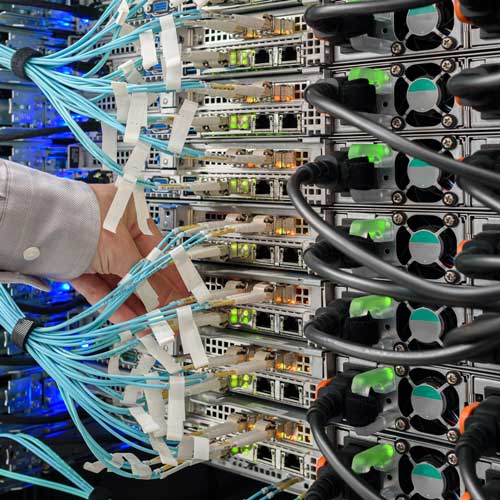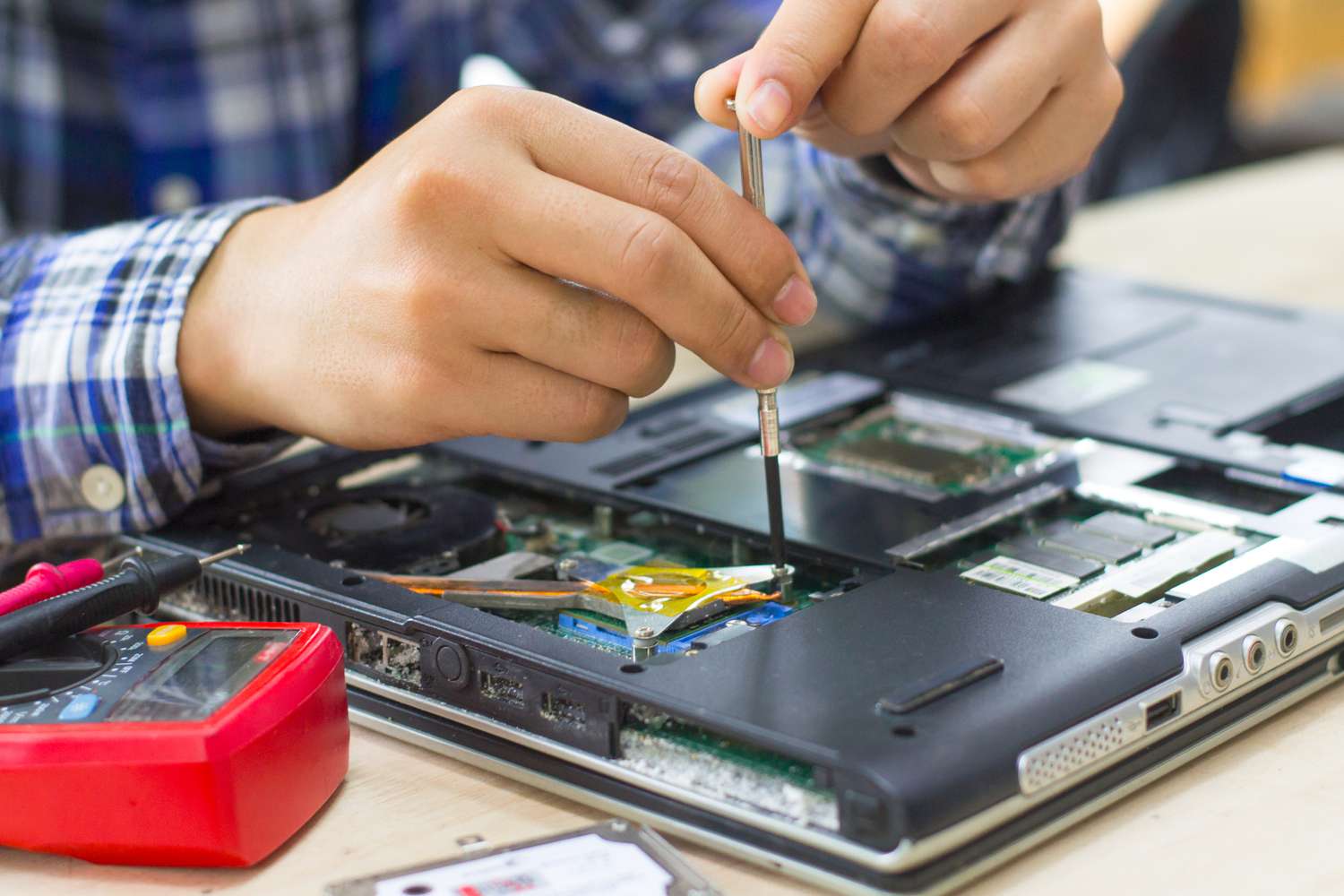Quickly fix your device.

1. If you haven’t already tried a simple restart (power cycle), I recommend doing that first. Many common issues can be resolved with a fresh reboot before diving into deeper troubleshooting steps.
2. Watch the video below for a step-by-step guide on performing a cold start to resolve common digital device issues.
If the video above didn’t resolve your issue, check out the hardware-specific guides below. Find the one that best matches your device’s symptoms and follow the steps.
Power supply, adapter
Symptoms:
A device may appear completely dead due to a fully drained battery that no longer holds a charge, a faulty power adapter, or a blown fuse. Other potential causes include damaged power cables or an internal failure in the power supply circuit.
Solution:
Start by ensuring a stable power source and verifying that electricity flows uninterrupted to the adapter or power supply. You can check this using an analog or digital voltmeter to measure the voltage at key points, such as the wall outlet and the adapter output.
Symptoms: A gradually spinning fan noise, flickering display, and flashing power light. This may indicate a component failure and/or a depleted or faulty battery.
Solution:
- If the power supply or adapter is connected,
unplug it. - Wait for 5 minutes, then try to power on the device without reconnecting the adapter.
- If the power light does not turn on, the battery is likely completely drained and requires a full recharge.
- First, follow the steps in the "The device is completely dead" section.
- After completing those steps, properly reconnect the power supply or adapter.
- Allow the battery to charge for at least 3 to 5 hours.
- Once charged, attempt to power on the device again.
Power On, Startup, boot up, loading
Symptoms:
High-pitched whining or grinding noises when the computer is starting up. This noise may disappear or become quieter after a while or persist. The sound can be intermittent, happening frequently or only on occasion.
Reason:
This symptom typically points to a failing fan or a hard disk drive. Devices such as desktops, workstations, servers, and laptops with cooling fans and HDDs can experience this issue. Additionally, power supply modules in desktops, workstations, and servers contain built-in fans that may also produce such sounds.
Over time, continuous usage and aging cause the fan’s bearings to wear out, and lubrication dries up, leading to increased friction that produces whining sounds. These fans are not user serviceable and should be replaced.
Solution:
If you’re comfortable working inside a computer, you can check if the fan is clogged with dust or debris, which may temporarily worsen the issue. Cleaning it with compressed air may help, but if the noise persists, the fan or the hard disk drive needs to be replaced. If you're unsure or not comfortable opening the device, consult a qualified tech lab for assistance or contact me for troubleshooting advice.
Symptoms:
This issue applies only to computers with mechanical hard drives (HDDs), not SSDs (Solid State Drives).
It is characterised by:
- Clipping or scratching sounds (not beeping) coming from the computer.
- The system slowing down, freezing intermittently, or becoming unresponsive.
- Restarting and functioning normally for a while, only to freeze again.
- A recurring loop of these symptoms.
Cause:
Over time, mechanical hard drives wear out due to continuous usage and workload demands. As they degrade, their ability to read and write data diminishes. If your computer is still operational but showing these symptoms, it's a warning sign of imminent drive failure, which may eventually lead to permanent data loss.
Solution:
⚠️ Immediate Action:
❗️ Back up important data (documents, photos, videos, music, etc.) right away.
Troubleshooting:
- Identify the failing drive (if multiple drives are installed). If unsure, seek my assistance.
- If the system drive is failing, replace it as soon as possible.
- For desktops:
- If you're experienced and know how to inspect the hardware safely, open the computer while it’s running (use caution).
- ⚠️ Caution: Always wear an anti-static wrist strap before handling internal components.
- 👂🏻 Listen closely to pinpoint the source of the sound.
- Replacement Steps:
- Power down the computer.
- ⚠️ Disconnect all power sources (wall socket, power adapters, batteries, etc.).
- Remove the faulty hard drive by unscrewing its mounting brackets or slot locks.
- Securely store the removed drive in an anti-static bag.
- Purchase a new HDD or SSD with identical specifications.
- Install the new drive in place of the old one.
Next Steps – Installing the OS
Once the new drive is installed, you'll need to install an operating system. For a step-by-step guide, refer to one of the Operating Systems section from the top navigation menu of this page.
Symptoms:
This applies mostly to older computers. When powered on, the computer may:
- Beep continuously or follow a specific beep pattern.
- Display a static logo but fail to proceed.
- Show a blank, dark, or black screen.
- Present graphical issues like horizontal/vertical lines, coloured squares, or random garbled text.
- Flash red, green, or blue screens.
Cause:
Observing the symptoms closely can help pinpoint the issue:
- If the beeping follows a pattern, refer to the Beep Codes Section to decode the error.
- If using an external monitor, check that the video cable is securely connected at both ends. Loose connections can cause display abnormalities.
- The problem typically indicates a hardware failure involving one or more of the following:
- Processor
- Memory (RAM)
- Embedded graphics or dedicated GPU
- Chipset or motherboard components
- BIOS corruption
- Power supply unit (PSU) or internal power control circuitry
If the beeping stops after some time, but the screen remains garbled, and a faint desktop or login screen is visible, the issue is likely with the video adapter.
Solution:
- For Laptops: This requires professional repair by an experienced technician.
- For Desktops & Workstations: If you have hardware knowledge and follow proper safety procedures, you may attempt troubleshooting. Check out the section how to replace your system disk if you need a step-by-step guide.
- Caution: Always use a wrist strap and proper grounding before opening the system to avoid static damage.
Display, Monitor, Screen
- Black Screen on Startup (No Display, But Power On)
- Symptoms: Power LED is on, fans are spinning, but nothing appears on the screen.
- Causes: Faulty RAM, disconnected internal display cable, corrupted BIOS, or display failure.
- Troubleshooting:
- Perform a hard reset: Disconnect power, remove battery (if removable), hold the power button for 30 seconds, then reconnect and try again. (This may depend on the brand of your laptop. refer to the related sections from the contextual navigation menus on top of this page.)
- Check with an external monitor—if it works, the built-in screen or connection is faulty. (External monitors can be connected to a laptop using HDMI, USB and DVI ports if the laptop is fitted with one.)
- Try removing and reseating RAM. (some laptop models have removable RAM slots. It is possible that the connections are dry and causing disconnections)
- Flickering or Flashing Display.
- Symptoms: The screen dims and brightens repeatedly, or horizontal lines appear.
- Causes: Loose internal display cable, outdated graphics driver, or hardware failure.
- Troubleshooting:
- Try adjusting the screen refresh rate in the display settings.
- Update graphics drivers. (In Windows™ use Device Manager, in MacOS use "System Preferences" and update. Refer to the related sections from the contextual navigation menu on this page.)
- Check if the flickering happens in Safe Mode—if not, it may be a driver issue. (To login to safe mode Windows™ or macOS is different. Refer to the relative section from the contextual navigation menu on this page.)
- Dim Screen / No Backlight
- Symptoms: Screen is very dark, but faint images are visible under a flashlight.
- Causes: Faulty screen backlight (LED or inverter issue) or loose or damaged internal display cable.
- Troubleshooting:
- Check if brightness is turned down (Fn + Brightness key on Windows™, F6 on macOS).
- Connect an external monitor—if it works, the backlight may be faulty. (some laptops are fitted with HDMI or USB ports, which can be used to connect a monitor.)
- Requires professional repair if it’s a hardware failure. (get the opinion of a qualified and experienced tech lab or contact me.)
- Coloured Lines, Blocks, or Artifacts.
- Symptoms: Vertical/horizontal lines, distorted colours, or pixelation.
- Overheating GPU, faulty internal display cable, or damaged screen.
- Troubleshooting:
- Check if lines appear in BIOS—if yes, it’s likely a hardware issue. (This applies only to Windows™ Operating System based laptops. For macOS based check the related section from the contextual navigation menu for Macs and macOS.)
- Connect your laptop to an external display—if it looks fine, the laptop screen needs replacement. (some laptops are fitted with HDMI or USB ports, which can be used to connect a monitor.)
- If using a dedicated GPU, try switching to integrated graphics in BIOS. (workstation class laptops are fitted with dedicated GPU cards in addition to the base embedded GPU for high performance graphics functionality. In Windows™ and macOS the switching can be set to automatically control by the apps that demand high performance GPUs. It may be set to manual within the Operating System or in the BIOS.)
Touchscreen problems can be frustrating, especially when ghost touches (random taps/swipes without user input) interfere with usability. Here’s a breakdown of the most common issues and solutions.
- Touchscreen Not Responding
- Possible Causes:
- Software glitches (OS or driver issues)
- Physical damage (cracks, screen protector interference)
- Dirt, moisture, or grease buildup
- Fixes:
- Restart the device – A simple reboot can resolve software glitches.
- Clean the screen – Use a microfiber cloth to remove dirt or moisture.
- Check for updates – Install OS and driver updates to fix touchscreen-related bugs.
- Calibrate the touchscreen – Some devices allow recalibration in settings.
- Boot into Safe Mode – If the touchscreen works fine in Safe Mode, an app may be causing the issue.
- Remove screen protectors – Some thick or poorly applied protectors interfere with touch sensitivity.
- Possible Causes:
- Ghost Touch (Phantom Taps & Swipes)
- Possible Causes:
- Electrical interference (from chargers, power supplies, or nearby devices)
- Defective digitizer (hardware fault). Requires the attention of a qualified and experienced tech lab. You can contact me.
- Overheating (causes touchscreen misbehavior) Requires a tech lab diagnosis. Contact me.
- Water damage (affects internal circuits). Refer to a tech lab or contact me.
- Fixes:
- Unplug the charger – If the issue stops, your power adapter might be faulty. Try using an original charger. ( ⚠️ cheap after market products can be dangerous due to the fact they are not manufactured to accepted standards. You are running a risk of severe electrical shock or fire hazard and injury to yourself. ❗️ All electrical apparatus' must be properly grounded.)
- Use a grounded outlet – Improper grounding can cause interference.
- Check for overheating – If the phone/laptop is hot, let it cool before use.
- Update firmware & drivers – Ghost touches are sometimes software-related.
- Test in a different environment – Try using the device away from power sources or high humidity.
- Possible Causes:
- Touchscreen Works Intermittently / Partially
- Possible Causes:
- Loose screen connections. (the internal display port connection is loose or damaged)
- Digitizer cable damage (often due to drops or finger pressure). The Digitizer is a component in the display system.
- Faulty drivers.
- Fixes
- Check for Operating System or driver updates – Uninstall & reinstall touchscreen drivers if necessary.
- Press gently around the screen edges – If pressing in certain areas restores function, the digitizer connection may be loose. Refer to a tech lab or contact me.
- 🏭 ⎌ Factory Reset – If the issue persists, backing up data and performing a factory reset can help rule out software issues.
- Seek Professional Repair – If all else fails, the touchscreen hardware might need repair or replacement. Refer to a qualified and experienced tech lab or contact me.
- Possible Causes:
- Symptoms: No Display on External Monitor
- Causes & Fixes
- Check Connection Ports & Cables: Ensure the HDMI, DisplayPort, USB-C, or VGA cable is securely plugged in on both the laptop and monitor. If possible, try a different cable.
- Switch Display Mode: Use Windows + P (Windows™) or Display Preferences (MacOS) to switch between screen modes (Duplicate, Extend, Second screen only).
- Try a Different Port: If your laptop has multiple video output ports, test with a different one.
- Causes & Fixes
- Symptoms: Monitor Not Detected / Incorrect Resolution
- Causes & Fixes
- Check Display Settings: In Windows, go to `Settings > System > Display` and click "Detect". On macOS, check "System Preferences > Displays".
- Update Graphics Drivers: Outdated drivers can cause detection issues. Update via "Device Manager" (Windows™) or "System Update" (Mac).
- Try Another Monitor: If possible, connect a different external monitor to see if the issue persists.
- Causes & Fixes
- Symptoms: Flickering, Artifacts, or Distorted Display
- Causes & Fixes
- Test with a Different Cable: A damaged HDMI, USB-C, or DisplayPort cable can cause flickering or artifacts.
- Check Refresh Rate: In "Display Settings", make sure the refresh rate matches the monitor’s specifications (e.g., 60Hz, 144Hz).
- Disable Adaptive Sync / G-Sync / FreeSync: Some external monitors have sync technologies that may cause flickering if not properly configured.
- Causes & Fixes
- Symptoms: External Monitor Has No Power
- Causes & Fixes
- Check Power Supply: Ensure the monitor is plugged in and powered on. Some USB-C-powered monitors may require additional power from an adapter.
- Test Another Power Source: Try plugging the monitor into a different outlet.
- Causes & Fixes
Keyboard Mouse
- Symptoms: Keyboard or Mouse Not Responding
- Cause: Loose or faulty USB connection, power issues, or driver conflicts.
- Fix:
- Unplug and reconnect to a different USB port.
- Check for visible cable damage.
- Restart the computer.
- Try the keyboard/mouse on another device to confirm if it’s working.
- Symptoms: Keys Not Registering or Sticking
- Cause: Dirt, debris, or hardware failure.
- Fix:
- Gently clean between keys with compressed air.
- If mechanical, remove the keycaps and clean the switches.
- If a specific key is faulty, it might need replacing.
- Symptoms: Keyboard Typing Wrong Characters
- Cause: Wrong keyboard layout or corrupted drivers.
- Fix:
- Check language and input settings.
- Reinstall the keyboard driver.
- Symptoms: Mouse Cursor Not Moving or Lagging
- Cause: Sensor obstruction, driver issues, or a faulty cable.
- Fix:
- Clean the sensor on the bottom of the mouse.
- Try a different USB port.
- Update or reinstall the mouse driver.
- Symptoms: Repeated or Phantom Key Presses
- Cause: Faulty switches or liquid damage.
- Fix:
- Try a different keyboard to confirm if it’s a hardware issue.
- If a single key is repeating, it might need repair or replacement.
This section covers issues not related to simple hardware faults, physical damage, or driver problems. These can include software conflicts, power management settings, and interference from other devices.
- Symptoms: Keyboard or Mouse Stops Working Randomly
- Cause: Power-saving settings may be turning off USB ports to conserve energy.
- Fix:
- Go to Device Manager → Find Universal Serial Bus controllers → Right-click each USB Root Hub → Properties → Power Management → Uncheck "Allow the computer to turn off this device to save power."
- Check in the BIOS/UEFI settings to ensure USB ports are not disabled. ⚠️ CAUTION! to make changes in the BIOS/UEFI requires thorough knowledge and experience of working on computer repairs. Do this at your own risk.
- Symptoms: Keyboard Shortcuts or Special Keys Not Working
- Cause: Some keyboards require special software or drivers for multimedia or programmable keys.
- Fix:
- Install the manufacturer’s official keyboard software (e.g., Logitech Options, Razer Synapse).
- Try a different USB port, as some devices require full USB power to function properly.
- Symptoms: Mouse Dragging, Double-Clicking on Its Own, or Clicking Delays
- Cause: Corrupt system files, system lag, or a failing switch inside the mouse.
- Fix:
- Start a Terminal session with CMD on Windows™ and Run sfc /scannow in Command Prompt (Admin) to repair system files.
- Adjust double-click speed in Control Panel → Mouse settings.
- If the mouse still behaves erratically, try using it on another PC.
- Symptoms: Sudden Unresponsiveness After Windows or macOS Update
- Cause: Sometimes, updates overwrite or remove essential drivers.
- Fix:
- Uninstall and reinstall keyboard/mouse drivers via Device Manager.
- Try rolling back the driver to a previous version.
- If using Windows™, check Settings → Update & Security → Troubleshoot and run the keyboard/mouse troubleshooter.
- Symptoms: Keyboard or Mouse Affected by Other USB Devices
- Cause: Some USB devices (printers, external drives) interfere with data transmission.
- Fix:
- Try plugging the keyboard/mouse into a different USB port.
- Avoid using unpowered USB hubs for high-power devices.
Pen, External Trackpads and Touchpads
- Symptom: Pen Not Responding at All
- Cause:
- Battery is dead (if applicable).
- Bluetooth pairing is lost (for Bluetooth-enabled pens).
- Outdated or missing drivers.
- Touchscreen is disabled in settings.
- Fix:
- If the pen has a battery, replace it.
- Re-pair the pen via Bluetooth (for Bluetooth pens).
- Check if the touchscreen is enabled in Device Manager (Windows) or System Preferences (Mac).
- Update or reinstall pen drivers.
- Cause:
- Symptom: Pen Input is Laggy or Inconsistent
- Cause:
- Low battery.
- Poor Bluetooth connection.
- Too many background applications using system resources.
- The display refresh rate is too low.
- Fix:
- Charge or replace the battery.
- Move closer to the device to improve Bluetooth stability.
- Close unnecessary apps.
- Adjust the display refresh rate if possible (some devices allow this).
- Cause:
- Symptom: Palm Rejection Not Working Properly
- Cause:
- Palm rejection settings are disabled.
- Conflicting touchscreen drivers.
- Faulty software or app compatibility issues.
- Fix:
- Enable palm rejection in the device settings or the specific app.
- Update touchscreen drivers.
- Test a different app to see if the problem is software-related.
- Cause:
- Symptom: Pen Buttons Not Functioning
- Cause:
- Buttons are not assigned correctly in settings.
- Software bug or missing driver update.
- Fix:
- Configure button settings in the manufacturer’s pen software.
- Reinstall or update the pen driver.
- Cause:
- Symptom: Pressure Sensitivity Not Working
- Cause:
- Driver issue.
- The app being used doesn’t support pressure sensitivity.
- Fix:
- Update drivers.
- Check if the app supports pressure sensitivity and configure it properly.
- Cause:
- Symptom: Random or Ghost Touches When Using the Pen
- Cause:
- Digitizer or touchscreen issue.
- Other objects interfering with touch input.
- Fix:
- Restart the device.
- Clean the screen and ensure there’s no dirt or moisture.
- Disable finger touch (if the pen supports pen-only mode).
- Cause:
- Symptom: Not Being Detected by the System
- Cause:
- USB-C or USB port issue.
- Bluetooth connection lost (for wireless trackpads).
- Drivers not installed.
- Fix:
- Try a different USB port or cable.
- Reconnect the trackpad via Bluetooth.
- Update or reinstall drivers.
- Cause:
- Symptom: Unresponsive Gestures (Two-Finger Scroll, Pinch to Zoom, etc.)
- Cause:
- Gestures are disabled in settings.
- Driver incompatibility.
- Fix:
- Enable gestures in system settings.
- Reinstall or update the trackpad driver.
- Cause:
- Symptom: Cursor Movement is Erratic or Jittery
- Cause:
- Dirty or damaged surface.
- Interference from nearby wireless devices.
- Fix:
- Clean the trackpad surface.
- Move TrackPad away from other wireless devices.
- Cause:
- Symptom: Trackpad Disconnects Randomly
- Cause:
- Bluetooth interference.
- Battery running low.
- Fix:
- Charge or replace the battery.
- Reconnect via Bluetooth and update drivers.
- Cause:
- Symptom: Trackpad Buttons Not Working
- Cause:
- Hardware failure.
- Software bug.
- Fix:
- Restart the system.
- If it is a physical button issue, the trackpad may need repair.
- Cause:
- Symptoms: Completely Unresponsive Touchpad
- Cause:
- Touchpad is disabled in settings.
- Driver issues.
- Fix:
- Enable the touchpad in settings.
- Reinstall or update drivers.
- Cause:
- Symptoms: Cursor Jumping or Moving Erratically
- Cause:
- Touchpad sensitivity too high.
- Dirty touchpad surface.
- Fix:
- Lower the sensitivity in settings.
- Clean the touchpad.
- Cause:
- Symptoms: Left or Right Click Not Working
- Cause:
- Physical damage.
- Driver issues.
- Fix:
- Check for software issues first.
- If the button is physically stuck, professional help is required to repair.
- Cause:
- Symptoms: Gestures Not Working
- Cause:
- Gestures disabled in settings.
- Outdated drivers.
- Fix:
- Enable gestures in settings.
- Update or reinstall drivers.
- Cause:
- Symptoms: Touchpad Disables Itself Randomly
- Cause:
- Auto-disable feature enabled.
- A key combination was accidentally pressed.
- Fix:
- Check settings for auto-disable options.
- Use the function key (Fn + Touchpad key) to toggle it back on.
- Cause:



